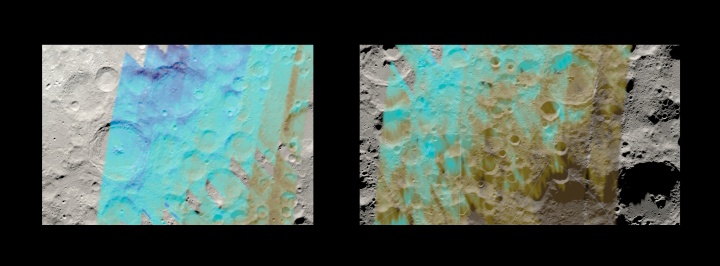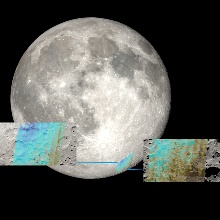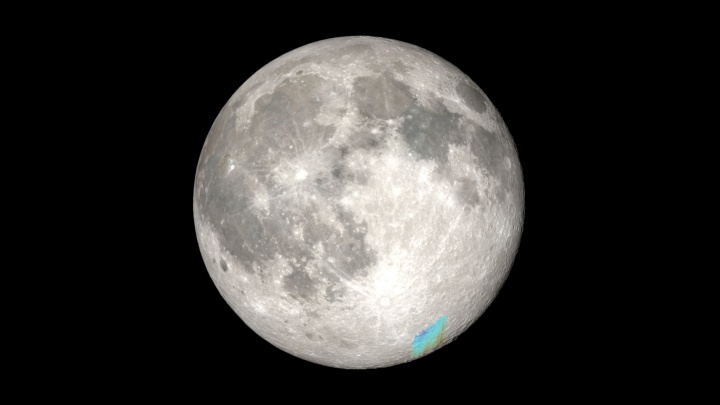A new study based on data from the Stratospheric Observatory for Infrared Astronomy (SOFIA), a joint project by NASA and the German Aerospace Center (DLR) has produced the first detailed, large-scale water map of the Moon near its south pole. This map shows that the local geography of the moon plays an important role in the amount and distribution of the available water: There is more water on the shady sides of craters and mountains than on sunlit slopes or plains - a phenomenon we know from skiing.
"When we look at the water data, we can see crater rims and the individual mountains," said Bill Reach, director of the SOFIA Science Center at NASA's Ames Research Center in California's Silicon Valley and lead author of the study, which he presented at the 2023 Lunar and Planetary Science Conference. "The differences between the sunny and shady sides of the mountains are visible thanks to the higher concentration of water in shady places."

As early as 2020, researchers were able to use data from SOFIA to provide the long-awaited, unequivocal proof that molecular water is also present in the warmer regions of the lunar surface that are illuminated by the sun, and not just at the shady poles. Previous space missions to observe the lunar surface examined other wavelengths of light and could not distinguish water from molecules similar to hydroxyl.
"The new map of the Earth-facing side of the lunar surface extends from the 60th degree of latitude to the Moon's South Pole," explains Bernhard Schulz, SOFIA Science Mission Operation Deputy Director at the University of Stuttgart, which coordinates the SOFIA project on the German side. "With this data, we can see how water is distributed on the moon at different positions of the sun, or lunar diurnal times. This should tell us more about the origin of the observed water."
The water on the Moon may be present in the soil as ice crystals or water molecules chemically bound to other materials. Where the moon's water comes from - whether it is contained in the moon's minerals or supplied exclusively by comets and solar wind - remains uncertain. However, it is clear that the Moon harbors much larger quantities of water than we previously thought.
A crucial resource for future missions
"Water is a crucial resource if humans want to explore the moon in the long term, or use it as a springboard for missions to Mars," explains Reinhold Ewald, a European astronaut and professor at the University of Stuttgart's Institute of Space Systems (IRS). "The more water we find already on the moon, the easier it will be to implement these projects."
Additional observational data from other locations on the lunar surface are stored in the SOFIA archive and are currently being analyzed. "In this way, SOFIA will continue to make significant contributions to the prevalence and distribution of water on the lunar surface despite the termination of observational operations at the end of September 2022," says Schulz.
Links to current news:
- SOFIA Reveals Map of Moon’s Water Near Its South Pole, NASA News, March 15, 2023
- SOFIA Finds More Water in the Moon’s Southern Hemisphere, NASA blog, August 26, 2022
- SOFIA the flying observatory discovers molecular water on the moon, DSI News, 26. October 2020
Further SOFIA links:
- SOFIA Science Center
- NASA SOFIA mission webpage
- NASA SOFIA blog
- SOFIA mission webpage of the DLR Space Agency
- DLR SOFIA project webpage
- DLR blogs on SOFIA
- To the SOFIA photo gallery
- To the news overview
- To the project chronicle
SOFIA, the Stratospheric Observatory For Infrared Astronomy, is a joint project of the Deutschen Zentrums für Luft- und Raumfahrt e.V. (DLR; funding reference numbers 50OK0901, 50OK1301, 50OK1701 and FKZ 50 OK 2002) and the National Aeronautics and Space Administration (NASA). The project was initiated by the DLR, with funding from the German Federal Ministry of Economics and Climate Protection (BMWK) as the result of a resolution passed by the German Bundestag and with funding from the state of Baden-Württemberg and the University of Stuttgart. SOFIAs activities are coordinated on the German side by the German Space Agency at DLR and carried out by the German SOFIA Institute (DSI) at the University of Stuttgart, and on the American side by NASA and the Universities Space Research Association (USRA). The development of the German instruments was funded by the Max Planck Society (MPG), the German Research Foundation (DFG) and the DLR.



